NevadaToday
In Deep Water The challenge of protecting our most precious resource
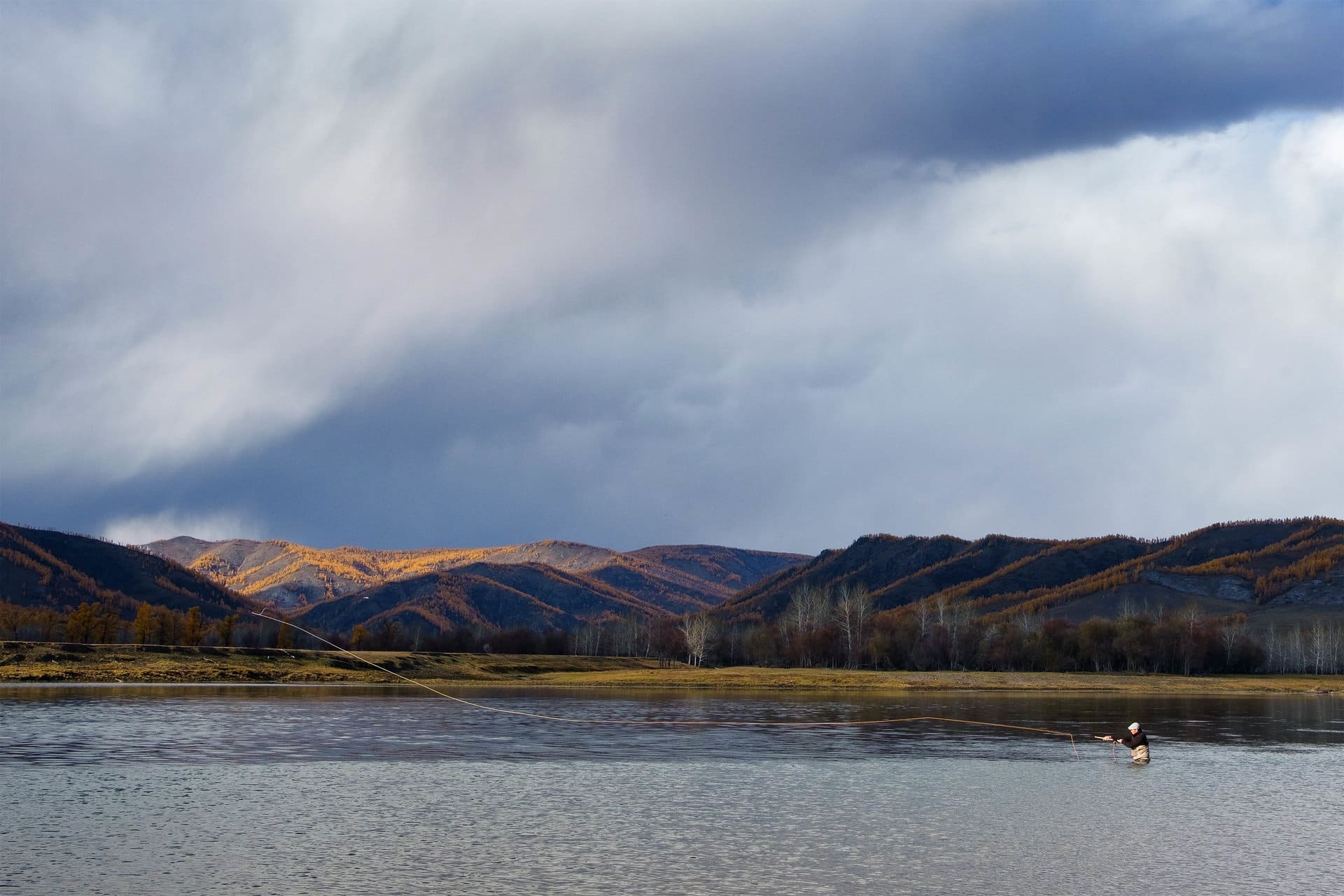
In Deep Water
Water is a precious resource. The University of Nevada, Reno Global Water Center works around the globe to develop creative, integrative approaches in solving complex issues related to water resources. The first stop is Cambodia where an interdisciplinary research team is working to find solutions to dams, overfishing and development that threatens the Mekong River and its ecosystem that’s relied on by millions of people for their livelihood and for food.
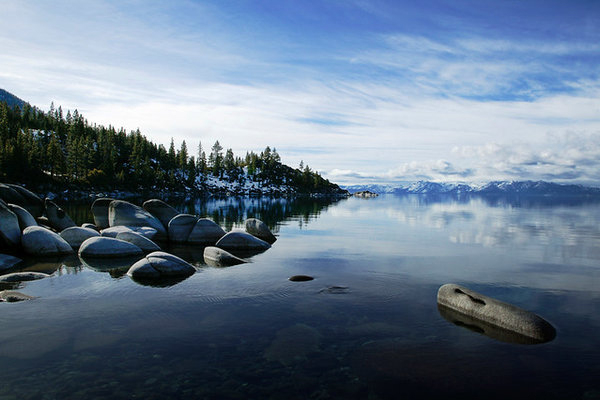
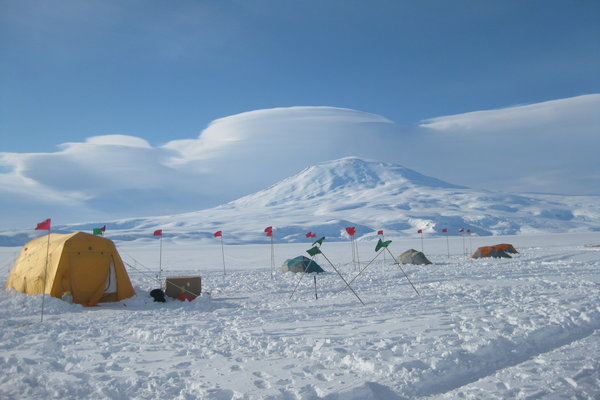
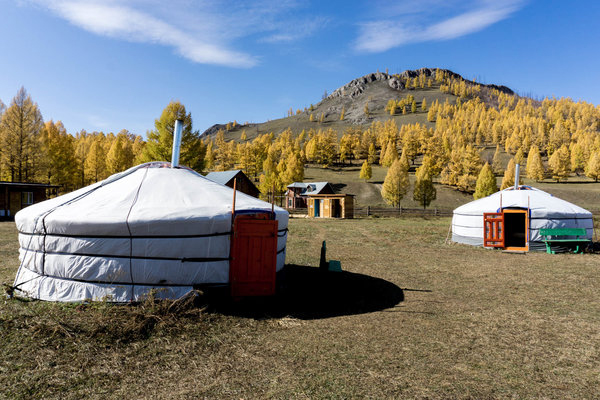
The scientists tackle a variety of problems on every continent, including the effects of climate change. They study events such as shrinking Antarctic ice shelves, melting permafrost in the Russian outback, carbon sequestration in Sierra Nevada forests, dwindling snowpack in Alaska and toxic algae growth in Guatemala’s Lake Atitlan. Closer to home, read about the 100 years of research at Lake Tahoe and the impact the University of Nevada, Reno has had in protecting the lake against warming waters, invasive plants and animals that are changing the ecosystem.
Wonders of the Mekong: studying and protecting one of the world’s largest river systems
Whether it’s working with young students in Cambodia, U.S. Senators, ambassadors, cabinet members or the Governors of Nevada and California, two University of Nevada, Reno biology professors have reached around the world – to thousands of people locally and millions of people globally – with a message about the importance of science and environmental stewardship.
Sudeep Chandra and Zeb Hogan have been friends and colleagues since their days earning doctorates at the University of California, Davis 21 years ago. Their paths separated for a few years before they began working together at the University of Nevada, Reno nearly 10 years ago, and they’ve worked together on a dozen projects since.
Hogan, a conservation biologist, and Chandra, a limnologist and biologist, both from the College of Science’s Global Water Center, earned their chops on the lakes and rivers of northern California and Nevada, including Lake Tahoe. They’ve taken their research skills to dozens of locations in Asia, Australia, the Middle East, Europe and North and South America, including the Nile in East Africa, the headwaters of the Amazon in South America, Lake Baikal in Russia, Lake Atitlan in Guatemala and the dangerous Salween River in Myanmar.
Now, with their years of experience and knowledge, they are expanding their focus to study and protect one of the biggest river systems in the world: the Mekong River. In order to study the river, they and their team immerse themselves in the communities and culture to better understand this massive river, its tributaries and how much the people and communities along depend on them.
Working with the United States Agency for International Development Asia Bureau, the Cambodian Inland Fisheries Research and Development Institute, and others based in Phnom Penh and under the auspices of the University’s Global Water Center, their research team officially launched the Wonders of the Mekong initiative in February 2017.
The launch event featured remarks from USAID-Cambodia Mission Director Polly Dunford and Secretary of State for the Ministry of Agriculture, Forestry and Fisheries Nao Thuok.
“The Mekong River, with its total length of about 2,700 miles, is the most productive river on Earth,” Thuok said. "The project will contribute to conserving the beauty and sustainability of this mighty river for the benefits of the people living on and along it.”
For more information about this project, check out Connected Rivers on Vimeo and Wonders of the Mekong on Vimeo.
The Wonders of the Mekong project is designed to bring increased awareness of the importance of the Mekong River and its ecosystem, which are vital to the economic and social health of Southeast Asia. The project will build institutional partnerships and develop educational materials to advance research on the importance of the Mekong River biodiversity and ecosystems.
“USAID is pleased to partner with the University on this important initiative that will help maintain the ecological, cultural and economic integrity of one of the most important river and delta systems in the world,” Dunford said.
The five-year project, “The Wonders of the Mekong: A Foundation for Sustainable Development and Resilience,” aims to preserve a functional, biodiverse and healthy Mekong River. It is funded by the U.S. Agency for International Development.
“This project is a great opportunity for us to share our knowledge and expertise on water and biodiversity issues with other institutions and learn from the experiences of experts in the Mekong River Basin,” Hogan, assistant research professor at the University of Nevada, Reno and lead researcher on the project, said. Hogan has conducted research on the river for 20 years with his Megafishes Project in which he finds, studies and protects megafish – more well known as monster fish – freshwater fish that are more than 200 pounds or six feet long.
In 2018, researchers made several trips to Cambodia working as part of a larger, interdisciplinary team.
On the ground in Cambodia
It starts with a 14-hour flight, with a long layover in Singapore, before the airplane lands in Phnom Penh. The Wonders team travels about an hour from the airport through dense traffic to a hotel near the research team’s project office along the river.
“We work closely with the Cambodian Fisheries Administration, they are an important hub for all of the work related to the river environment,” Chandra said.
On a recent trip, the team met with agencies and conducted trainings with local scientists and students from the Royal University of Phnom Penh and with staff of the fisheries administration, including with the internationally funded group called the Science Capacity Development Group. They move on from the hotel and stay in a rented, rustic place, living with a family further along the river.
The training began in the city, and soon the team and their Cambodian collaborators headed north, upstream on the Tonle Sap, beginning in Phnom Penh, where the Mekong and the Tonle Sap meet. Living on barges for this leg of the trip, they made stops where the outflows of the big lakes drain into the river. The students and volunteers, including Utah State collaborators, learned how to take water samples and gathered data on water characteristics. Everyone took a turn and caught fish as part of the research, as well, working through rainy nights and sunny days.
“We all spend 24 hours collecting data, living on the barge in the middle of the river; eat on the barge, take naps in hammocks and live with fisherman,” Chandra said. “We use special oxygen probes to sample the water and lay out chambers (small containers) to get substrates (dirt and rocks) from the riverbed. We’re looking at the metabolism of the river, to see how much oxygen is produced and consumed, which is an indicator of how much algae and bacteria production are supporting the fishes in the river. We’re looking at the breathing of the river in relation to placement of dams or no dams, in different seasons, with floods and productivity changes.”
On the water in Cambodia
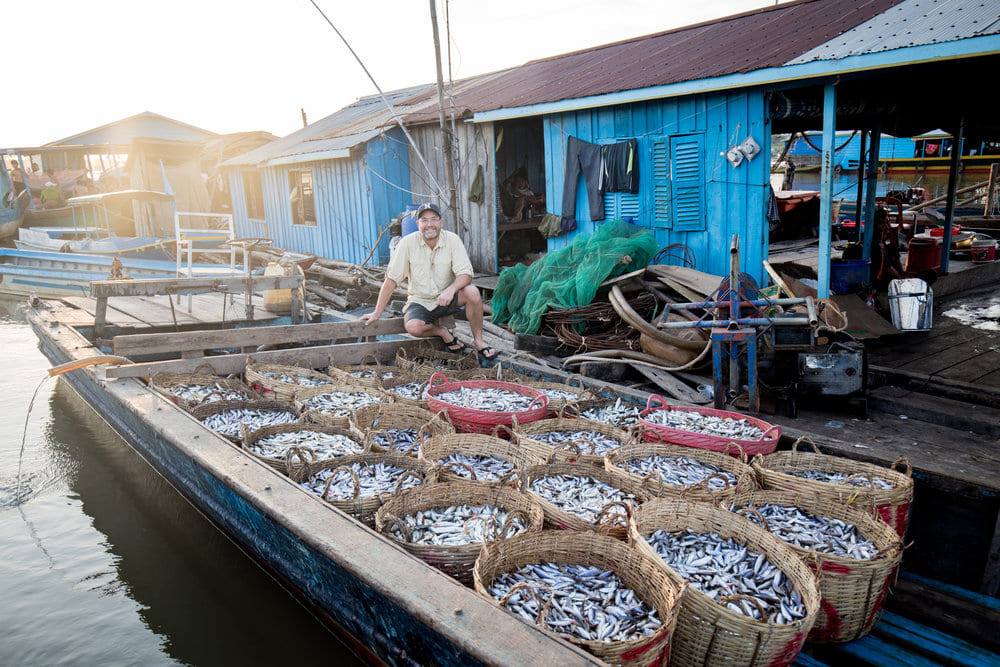
Like the physiology of the human body, the team is looking at the physiology of the lakes and rivers. They bring the samples home to Reno to run results in one of the University’s biology labs. They leave the mini oxygen probes in the river to continue gathering data. The people they’ve trained in Cambodia will return and move the probes to new locations, measuring the oxygen throughout the river system.
“Someone sent us carbon dioxide sensors, so we can also measure carbon that comes out of the river, so now we can look at the influence of the river on climate change, the amount of carbon the river is emitting into the atmosphere,” he said.
“We’re interested in fish production and sustainability needed to support communities all along the river,” he said. “So why not just measure fish production – how many fish are here? We measure the entire productivity of river, not just counting the number of fish. With just counting fish, there is a delay in knowing what dams will do to the river system and how it can change the system. If we know what and how many nutrients are in the river, how much food it supplies, we can predict fish production and the health of the river system.”
With more than 60 million people depending on its aquatic resources for food and livelihoods, the lower Mekong River Basin is threatened by rapid development that would adversely affect the people and wildlife within this region. Hydropower development on the Mekong is accelerating and could reduce fishery yields by 30 to 40 percent, equaling nearly 1 million tons annually. Sediment loads necessary for rice fields would be reduced by more than 90 percent.
Science for sustainability
It’s a one-way trip upstream for the team. After moving up the Tonle Sap River about 40 miles, they take a half-day drive east to an undammed river – the Sekong, a tributary to the Mekong. They pulled their vans into their next base of operations, a small village, and were greeted by water buffalo.
“In Sekong, way way upstream – there are communes there, we lived there next to the river. It’s a huge river,” Chandra said. “You feel the power of it, and you can see how on this scale millions of people are getting fed through the river system. You see how people are living off the river.”
“As more dams are proposed to go up on the Mekong system, we are looking at what the influence is on productivity of the river; we have to have a starting point – what does a system look like before and after dams,” he said. “We especially look at the Tonle Sap because of the huge seasonal fish migration to the Mekong, the corridor for so many species of fish. But we measure byproducts of production like oxygen and carbon used, which gives a more immediate sense of change that’s about to happen.”
The dam proposed for the Sekong is not for water storage; it’s for hydroelectric power for Cambodia. Most of the dams along the Mekong system are independently operated. They are not coordinating operations, and this can mean lost efficiency and increased disruption to the environment. Laos has a plan and timeline for their dams, but need partners to evaluate the environmental impact, especially on a basinwide, cumulative scale,” Hogan said.
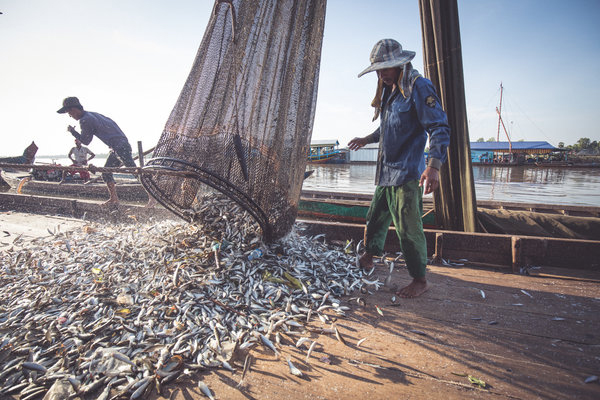
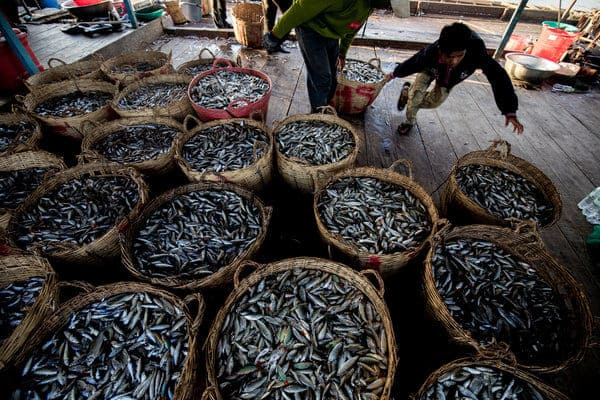
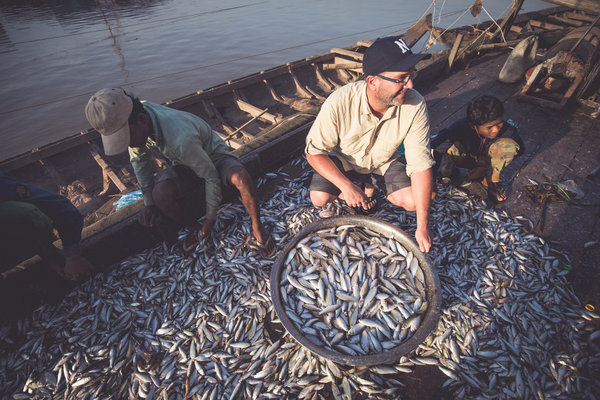
While Chandra focuses on the living, breathing river and its ecosystem, Hogan looks at the fish and other aquatic life.
“One of the things we’ll look at is how the fish are moving and how they might be impacted when a dam is built,” he said. “We’ll compile historical data on fish abundance and diversity and look for patterns over time – there’s a lot of raw data.”
Hogan has plans to gather even more and comprehensive data on fish abundance, migration and spawning. They’ll do more frequent samplings, every day during peak season, day and night using graduate students, citizen scientist volunteers and fishery staff.
“We’ll sample each month – June, July, August and September – to see what fish are out there,” he said. “The team will start at Phnom Penh and go up to Tonle Sap Lake, looking especially at the Giant Catfish and Giant Carp which are the two largest fish in the ecosystem, plus ‘trey riel,’ or money fish, the fish that is the staple of the Cambodian diet the base of the food chain and the lifeblood of the region. There are dozens of fish species; we also want to see where and when they are spawning.”
The Tonle Sap system is of keen interest as it reverses flow seasonally between the lake and the Mekong River 72 miles away. The ebb and flow aids the fish migration.
“We’ll watch the flood pulses and the fish’s reaction to the flows as the water reverses direction,” Hogan said. “Migrating fish are an extremely important component of the ecosystem services that the Mekong River and its tributaries provide each year,” Hogan said. “The fish harvested from the Mekong River basin have an estimated value of over $10 billion.”
Illegal fish harvest
The value of the fish threatens them with overharvesting and illegal harvesting – especially the megafish. The Giant Barb and Giant Catfish in the Mekong top the list in this region.
Since he began finding, studying and protecting megafish as part of his research that began 20 years ago, Hogan has become an expert on the giant fish of the Mekong River system. His travels and studies have been chronicled in his NatGeo Wild show, Monster Fish. Through the show, and his work as a National Geographic Explorer, Hogan has helped with conservation efforts for Monster Fish around the world as well as the Mekong.
With his colleagues at the Cambodian Inland Fisheries Research and Development Institute, they worked out agreements with the local fishermen to have them report their monster catches before releasing the fish. Once the scientists measure, weigh and tag the fish, the fishermen release the fish and receive a small payment for helping out. It is illegal to harvest these giant fish. Fewer and fewer of these monster catches are being recorded – down from as many as 12 a year to one or two a year – and Hogan is afraid that means an increase in illegal harvesting for the Giant Barb and Giant Catfish, which can be worth thousands of dollars each.
“The new illegal trade appears very pervasive and growing very rapidly,” he said. “It needs to be dealt with if these species are going to survive.”
As part of the Global Water Center efforts with the Wonders of the Mekong project, Hogan is bringing together the scientists, the governments along the Mekong and conservationists to continue and strengthen protection of the monster fish, which number about eight species out of the almost one thousand species of fish in the river system, the most species of any river in the world. The big fish are representative of incredible diversity and productivity.
The river supports a fisheryvalued at between $5 billion and $11 billion per year
The river supports a fishery valued at between $5 billion and $11 billion per year. Overall, the river- its ecosystem’s services valued at hundreds billions of dollars - supports modern day cities like Phnom Penh and Siem Reap. These “wonders” of the Mekong – its fisheries, biodiversity and ecosystem services – are based on a healthy, functional Mekong River.
“Knowing that the river and fish it supports are vital to the economic and environmental health of the communities along the river makes it easier to gain support to protect the ecosystem and the sustainability of the economy, the goal of the Wonders project,” Hogan said.
To achieve this goal, the project is taking an interdisciplinary approach conducting applied research, building capacity and developing outreach and communications products to highlight the economic, ecological and cultural values of biodiversity and ecosystem services associated with the Lower Mekong River.
“The outputs and resulting products, developed as an integrated package, will help to maintain healthy, natural systems that provide goods and services that sustain life and improve human wellbeing,” Hogan said.
Interdisciplinary approach
Hogan and Global Water Center Director Chandra assembled an interdisciplinary team from the University of Nevada, Reno including:
- Peter Weisberg, forest ecologist and biogeographer in the University’s College of Agriculture, Biotechnology and Natural Resources
- David Crowther, science education professor and executive director of the University’s Raggio Research Center for STEM Education
- Thomas Dilts, research landscape ecologist with skills in Geographic Information Systems, remote sensing, habitat modeling, habitat connectivity modeling, landscape genetics
- Bonnie Trejo, research faculty member in the Aquatic Ecosystems Laboratory in the College of Science’s Biology Department
“Project activities will further develop over the next few years,” Hogan said. “We’re looking at forest inundations and flooding, creating educational materials to increase awareness about the role of the river, building a curriculum around fisheries and Wonders of the Mekong that our partners will aim to institute at a national level.”
Sudeep Chandra: sharing knowledge around the globe
Limnologist and Conservation Ecologist Sudeep Chandra is always smiling. His gregarious approach to science is infectious, and like a pied piper, graduate students and colleagues line up to work with him. He’s had 25 graduate students in his 20 years at the University, and he is always looking for new ones. He is a cheerleader of sorts – he calls it mentoring – for new faculty and students as they get their research projects off the ground. He’s always looking for ways to collaborate, be inclusive and take a team approach to a project.
He has published numerous scientific papers through his Aquatic Ecosystems Analysis Laboratory. Sudeep Directs the Global Water Center and runs a Long-Term Ecological Research Station at Castle Lake, located in northern California. The research at the station is in its 61st year of data collection and the work at the research station allows students to understand how climate change affects lake biodiversity and fish dynamics.
Sudeep works with scientists around the world. He studied under the grand master of Lake Tahoe research, Charles R. Goldman from U.C. Davis, and is now – since Goldman’s retirement – recognized as one of the most experienced scientists working at the high-altitude alpine lake that straddles the Nevada/California border. As a result of his work there, he serves on behalf of the University on the recently created Lake Tahoe Science Advisory Council which supports managers in making science-based decisions to protect the 11th deepest lake in the world. The main body of the research in Sudeep's lab is concerned with how invasive species impact Lake Tahoe's fragile ecosystem and supplying managers with information on how to prevent the introduction of new species.
He’s just at home in the laboratory as he is giving a lecture, working with his students to understand how rivers function with a grant from the National Science Foundation or rowing a small boat in the chilly Siberian Arctic gathering water samples. He’s even in his element talking policy and funding for research with senators, congressmen, ambassadors, governors and presidents.
Chandra’s Tahoe work has informed projects and scientists around the world as they apply Tahoe methods and systems for slowing or stopping ecological decline. For instance, in 2010 Chandra built a collaboration through the U.S. State Department and with Guatemala’s government to study and protect their huge Lake Atitlan, which began having toxic algae blooms in 2008.
Lake Atitlan, Guatemala
The algae made a spectacular explosion of color on the surface of the 50-square-mile lake, as seen from space in satellite photos, drawing attention to its dramatic decline.
“Lake Atitlan is very similar to Lake Tahoe in size and character, but without the environmental protections Atitlan declined in water quality over the years from the impacts of increased population,” Chandra said. “ The algae made a spectacular explosion of color on the surface of the 50-square-mile lake, as seen from space in satellite photos, drawing attention to its dramatic decline.”
“Our collaboration can help move the management forward by decades by adding to their work the lessons learned at Tahoe since water quality management of Tahoe began 40 years ago,” Chandra said. “Atitlan is at a crossroads for management, and it needed it sooner rather than later.”
The American team of fisheries ecologists, limnologists, water quality experts and wetlands scientists teamed with about 20 scientists, engineers and students from Guatemala to set up a lab and monitoring infrastructure for the lake, to build on the research that began in, and has continued intermittently since, the 1970s.
The USAID-funded project determined the causes of the problem at Lake Atitlan, including the loading of sewage inputs and erosion from the watershed. He and his team from the University of California, Davis, work tirelessly with the nonprofit community at Lake Atitlan to convince policy makers to collect and export sewage for use by coffee growers outside of the watershed. The exportation of sewage is a similar approach used to conserve Lake Tahoe and a dozen other lakes, rivers and estuaries in the world.
At home at Lake Tahoe
Back at Tahoe, Chandra works with local, state and federal agencies to foster research that informs public policy. For one example, after he and his team at the University’s Aquatic Ecosystems Analysis Laboratory showed that the invasive and ecosystem-destroying quagga mussel could live and thrive at Lake Tahoe, a new policy was enacted to require boat inspections and cleaning before the craft could enter the lake.
The program, now in its 11th year, requires all motorized watercraft to be inspected for aquatic invasive species prior to launching into Lake Tahoe or neighboring Fallen Leaf Lake, Echo Lake and Donner Lake.
Quagga mussels, New Zealand mudsnails and hydrilla are just a few of the invaders the managers of Lake Tahoe are trying to keep out of the lake. They can cause large ecological disruptions once they invade an aquatic ecosystem. Invasive species destroy fish habitat, ruin boat engines and negatively impact water quality, which can in turn affect the local economy, recreation and ecosystem.
Since 2008, Tahoe Resource Conservation District inspectors have performed more than 70,000 vessel inspections, finding hundreds of vessels containing foreign species such as mussels, snails and plant material, which were decontaminated using hot water.
Native fish decline
In another project at Tahoe, Chandra and his team completed a lakewide study that found a considerable decline in native fish species density at Lake Tahoe since 1951. In their final report, they recommended establishing and implementing a management plan to protect the nearshore zone habitat, which is critical to native fish.

Chandra and his team used a two-pronged approach to boosting the native fish population. At the south end of the lake, they harvested invasive warmwater fish. Combing the Tahoe Keys with an electroshock boat that stunned the fish, the researchers scooped them out of the water, sorted out the invasives and threw the natives back. While harvesting, they found a record large goldfish that made headlines in the news. The native fish were released back into the lake, and thousands of invasive warmwater fish were removed and donated to a Reno Catholic Charities Food Bank, where they fed the homeless. Sudeep is always thinking up opportunities to link science studies to the betterment of society and those in need.
While this team of researchers was removing invasives, another team was experimenting with restocking the native Lahontan Cutthroat Trout in Emerald Bay. The large trout disappeared from Tahoe in 1939. Chandra conducted a study that found 58 percent of the 26 historically sampled locations surveyed around the lake showed a decline of species or no native species at all.
Several species of non-native coldwater sport fish, including Mackinaw, rainbow, brown and brook trout, had been intentionally introduced to Lake Tahoe in the early 1900s to provide and support recreational sport fishing. Mackinaw trout, brought here from Michigan in 1894, contributed to the extinction of Tahoe’s native Lahontan cutthroat trout. If the managers at Lake Tahoe are going to recover and restore native Lahontan Cutthroat Trout to Tahoe, Sudeep suggests there needs to be much more research support for quantifying how invasive species and climate change will influence the recovery of this famous trout.
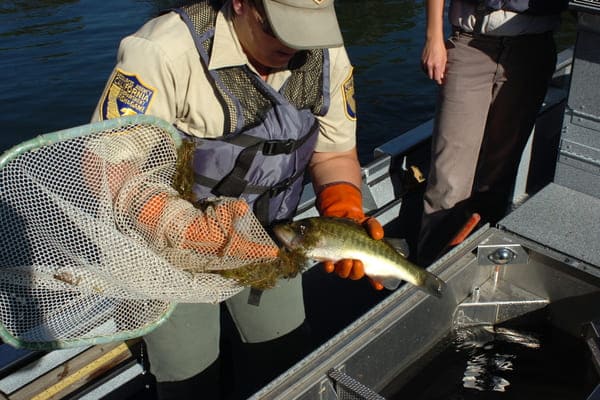
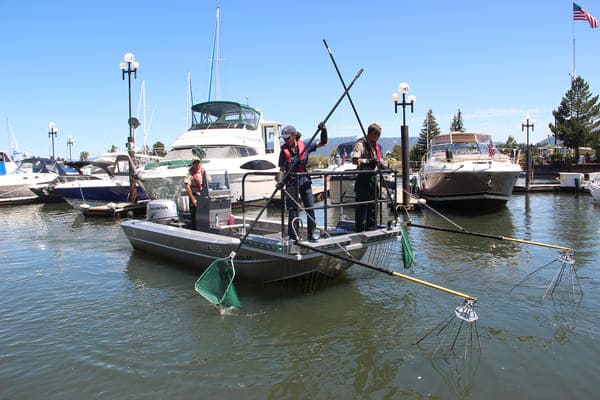
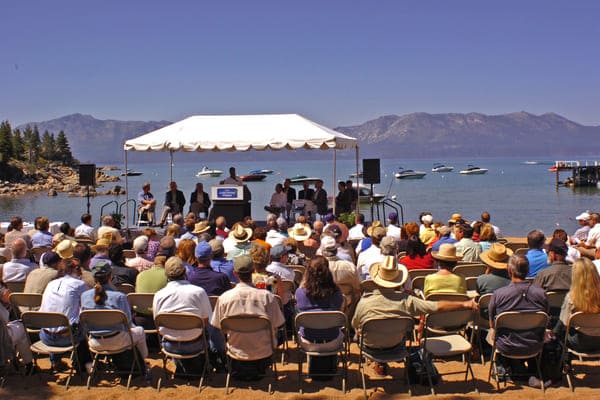
In his travels to study rivers, lakes and their ecosystems, Chandra saw a need to combine efforts among University scientists and scholars for a more effective approach to global water resource issues. His idea spawned the “Global Water Center: Solutions for Sustainability,” based at the University of Nevada, Reno. It was created as a response to what Chandra and his colleagues saw as societal demands to develop creative, integrative approaches in solving complex issues related to water resources. He led the formation of the new center.
"The issues surrounding water resources, water quality and ecosystems aren't just single-focus that can be solved by isolated scientific disciplines or individual scientists – they are multidimensional and need collaborative data-driven solutions," he said. “Developing a center to focus our work was a no-brainer, we got immediate buy-in from colleagues throughout the University as well as other institutions around the West.
The Center addresses the increasing pressure put on the Earth's water resources by climate change, invasive species, dam development and diversions, pathogen occurrence, nutrient deposition, pollution, toxic chemicals and increasing human demands for water. Undergraduate students, graduate students and postdoctoral scholars will work on interdisciplinary research projects, which contributes to experiential learning and augments classroom instruction for specific disciplines.
The University of Nevada, Reno’s Global Water Center was established in July 2016 with approval from the Nevada System of Higher Education’s Board of Regents. The Center supports and has active participation of 22 faculty from seven departments and six colleges, including:
- College of Agriculture, Biotechnology and Natural Resources
- College of Science
- College of Engineering
- College of Education
- College of Liberal Arts
- University of Nevada, Reno Cooperative Extension
Since the Global Water Center opened its doors, 16 interdisciplinary proposals have been submitted by faculty from across the colleges. Five proposals have been funded, generating almost $5.5 million dollars in awards. Ten scientific publications have been generated with the Global Water Center identification, including one in the prestigious Proceedings of the National Academy of Sciences and one letter submission to Science .
Projects based in the Global Water Center are in places such as Mongolia, Chile, Antarctica, Guatemala, Mongolia, Vietnam/ Laos, Italy, Hawaii and Uzbekistan. United States locations include the Great Lakes, Crater Lake in Oregon, Lake Tahoe, Shasta Lake, Castle Lake near Mt. Shasta, the Truckee River between Lake Tahoe and Reno, and Alaska.
A legacy of protecting the Lake Tahoe environment and economy
In 1895 University of Nevada, Reno professor James Church made the first mid-winter ascent of the 10,700 foot Mt. Rose on a dare and in 1901 spent Christmas vacation nearby in the open at the crest of the Carson Range of the Sierra Nevada – in the University’s backyard.

His intellectual fascination with the mountains and snow that provided water to the Truckee Meadows led him to begin exploring how the water cycle worked. He and Samuel B. Doten of the University’s Nevada Agricultural Experiment Station established the Mt. Rose Observatory, a weather observatory, in 1906 on the summit of Mt. Rose to record data on snow deposits, wind velocities and runoff. It was the first of its kind in the world. Church and his associates built the observatory by hand, carrying all materials to the summit either by horseback or in backpacks. A professor of classics and art history, he became known worldwide as the "father of snow science."
One could say snowpack/streamflow monitoring on a global scale started here in 1905 on the flanks of Mt. Rose overlooking Lake Tahoe and Reno, with the first snow survey system developed by Church. He was interested in determining how much snow runoff would supply water to Reno and the northern Nevada area. The survey soon extended across the Sierra and now helps forecast California’s water supply, including agricultural and domestic uses.
Church's methods and his snow sampling device were adopted around the world by other scientists. He set up monitoring systems in the Andes, the Himalayas and Europe. While new technology is making advances in snow measurement techniques, the tried and true methods Church developed overlooking Lake Tahoe are still used as a standard.
His trek and subsequent research were unknowingly the start of decades of Lake Tahoe research by University of Nevada, Reno professors and their students. With Lake Tahoe just 35 miles away, the campus affords quick access for researchers and their students. Mt. Rose and the peaks of the Carson Range, forming the lake’s eastern edge, are prominent in the skyline above the campus – a constant lure for curious scientists.
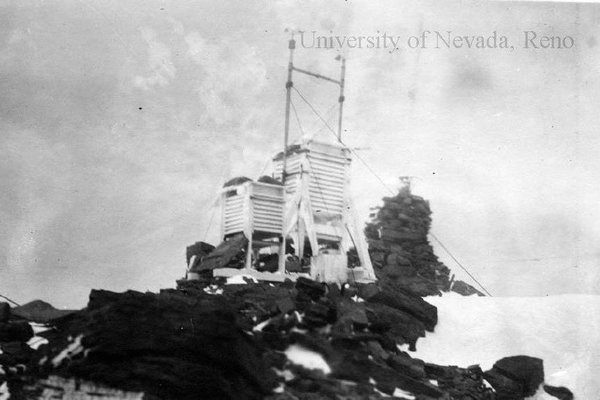
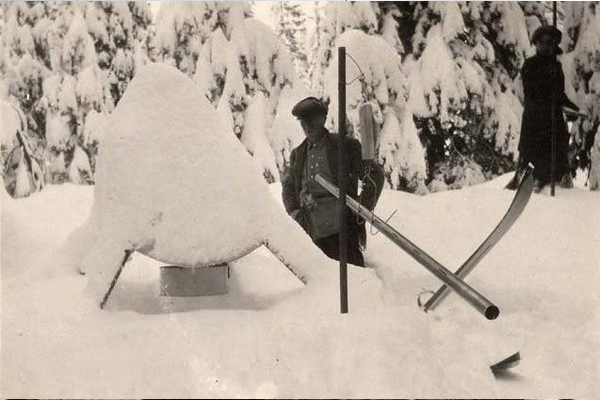
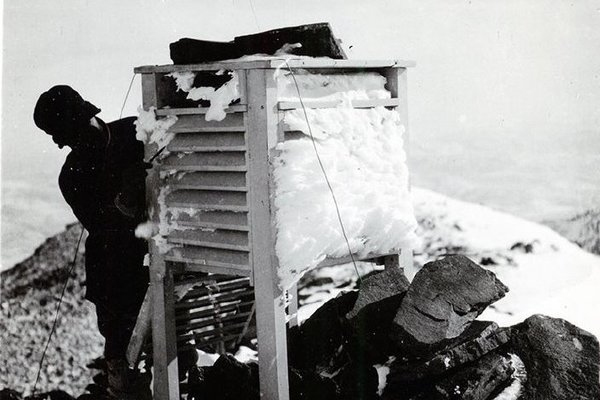
And it’s not just research but policy, and implementation of policy in which University alumni have had important roles, guiding the protection of the lake, the local economy and the surrounding forests and mountains. Nevada alumni are and have been lead educators, scientists, policy-makers and agency managers at the lake.
The Father of TRPA
Nevada State Senator Coe Swobe, an alumnus himself, was a staunch supporter of the preservation of Lake Tahoe. He graduated from the University in 1954 with a degree in political science and history before getting his law degree.
One of the most significant conservation measures in the history of the nation… designed to protect a priceless treasure
During his tenure as a Nevada Senator from 1967 to 1974, he led the way in building the first agreement between then Nevada Governor Paul Laxalt and California Governor Ronald Reagan – and the two state legislatures – which resulted in the Tahoe Regional Planning Compact of 1969. The bi-state compact bill was nicknamed “the Swobe bill.” Laxalt called the bill “ one of the most significant conservation measures in the history of the nation … designed to protect a priceless treasure.”
The compact led to the formation of the Tahoe Regional Planning Agency, a bi-state agency that oversees, regulates and leads cooperative efforts to preserve, restore and enhance the environment of the lake. Swobe was considered the father of the TRPA because of his public policy contributions leading to the adoption of the compact and its implementation over the past four decades.
He championed the need to reduce the presence of natural fuels in the lake, fuels putting the Tahoe Basin at risk from destructive fires. He expanded the park system and also worked to protect the lake from the effects of an uncontrolled construction boom. Swobe served on the TRPA Governing Board from 2001 to 2008.
Nevada governors
While Lake Tahoe has been a priority to all Nevada governors since the compact, three of them received their undergrad degrees from the University of Nevada, Reno:
- Richard Bryan, governor from 1983 to 1989
- Jim Gibbons, governor from 2007 to 2011
- Brian Sandoval from 2011 to 2018.
Prior to becoming governor, Sandoval served for three years as Nevada’s at-large member on the TRPA Governing Board. He continues to support protecting the lake. Sandoval earned his degree from the University of Nevada, Reno in 1986 and has rarely missed a Lake Tahoe Summit since it began in 1997.
At the 2017 annual Lake Tahoe Summit, he said, “Tahoe is in our DNA; we have to do whatever it takes to make sure that we keep the sediment out of the lake, that we prevent wildfires and keep the air clean – everything that we have control over to ensure that this remains one of the finest places the Earth affords.”
Governors aren’t the only elected officials from Nevada who support research and environmental protections at Lake Tahoe. Perhaps Nevada’s greatest champion for Tahoe is former United States Senator Harry Reid. His long connection and support of University research in a number of disciplines have moved science forward, including at the lake, leading to a number of on-the-ground improvements, such as stream and drainage improvements, fire mitigation and invasive species control, as he played an instrumental role in bringing unprecedented attention and funding to Lake Tahoe.
Passing the torch
After Reid’s retirement from the Senate in 2016, the newly elected U.S. Senator Catherine Cortez-Masto took up the torch for Lake Tahoe. At last year’s Tahoe Summit, the University of Nevada, Reno graduate talked about the importance of working to protect Lake Tahoe. Cortez Masto earned a Bachelor of Science in Business Administration in Finance from the University in 1986 before receiving her law degree from Gonzaga University School of Law in 1990.
“Thanks to Senators Reid, Feinstein and Boxer’s leadership over two decades, more than $2 billion in federal, state, local and private funding has been invested in Lake Tahoe,” she said at last year’s Tahoe Summit.
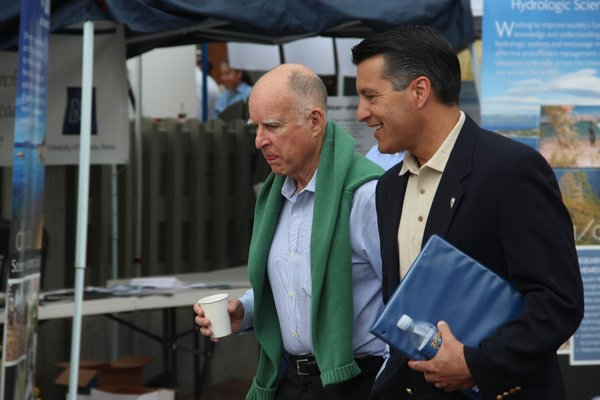
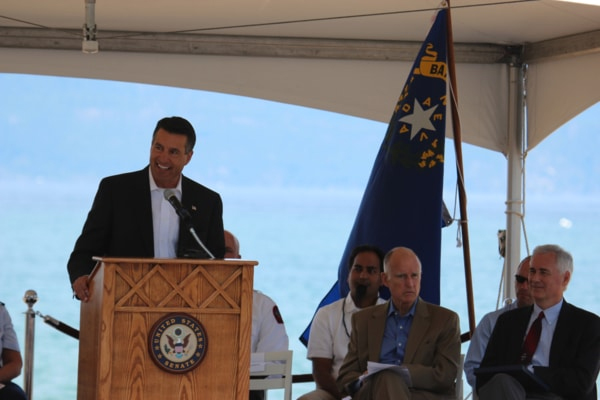
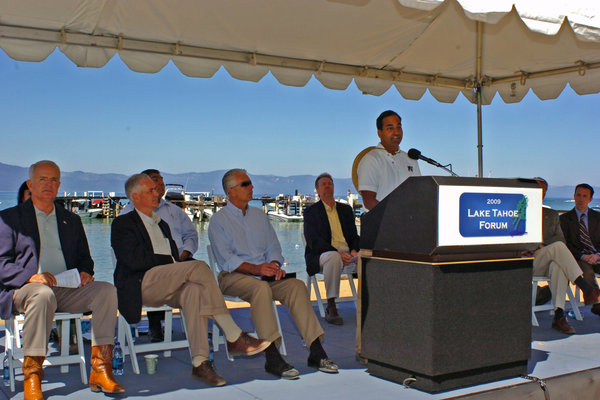
“That legacy continues today. The 2016 Lake Tahoe Restoration Act was passed. The bill authorized $415 million in federal dollars for key Environmental Improvement Programs. These funds are going to improve the quality of the water, protect against aquatic invasive species, mitigate the threat of wildfires, enhance Tahoe’s infrastructure and create a ‘smart lake’ that will better inform our scientists and create a more sustainable Lake Tahoe for its residents and visitors.”
Mark Amodei leads the Tahoe charge in House of Representatives
The Lake Tahoe Restoration Act was spearheaded by another Nevada elected official, Mark Amodei of the U.S. House of Representatives, where, as a member of the House Appropriations Committee, he has championed the legislation to protect Lake Tahoe. He is a 1980 graduate of the University of Nevada, Reno. Since 2011, in his days as a Nevada State Senator, he has been a supporter of protecting Lake Tahoe. As a congressman he was part of the bipartisan coalition of Nevada and California elected officials who supported securing the $415 million in federal funds to protect Lake Tahoe’s environment.
The legislation continues the federal commitment at Lake Tahoe by authorizing funding to ensure the federal-state partnership focuses on key priorities. He also helped increase the budget for USGS cooperative research units across the country, with hopes that the University of Nevada, Reno will be able to participate in a unit based around Lake Tahoe research.
“As one of the most spectacular bodies of water in the United States, anyone who has experienced Lake Tahoe’s natural beauty understands the importance of protecting this national treasure for future generations,” Amodei said. “This is why I have supported and introduced legislation throughout my tenure in Congress that makes the Lake a priority by responsibly investing in management solutions that will restore, preserve, and modernize the region.
“Most recently, I supported the Water Infrastructure Improvements for the Nation Act, legislation that included the Lake Tahoe Restoration Act, and made critical investments in projects to improve water clarity, reduce wildfire threats, combat invasive species, and invest in transportation and infrastructure projects through 2025. I will continue working to preserve and protect the Tahoe Basin so that all future generations have the same opportunity to enjoy Lake Tahoe’s natural beauty for many years to come.”
Taking a dive at Tahoe
Martin McClellan, president and project leader of New Millennium Dive Expeditions and a graduate of the University of Nevada, Reno, has been using new deep-water scuba diving technology to video Lake Tahoe research efforts, document clarity, lake bottom habitats, vegetation and aquatic life.
McClellen graduated from the University in 1987 with a Bachelor of Science in Business Administration before earning his MBA from Dean Witter Financial. He graduated from Edward C. Reed High School in Sparks in 1979. His new Millennium Dive Expeditions non-profit organization is enamored with Lake Tahoe, conducting water clarity research with their new Water Clarity Stations, six of them situated in relatively shallow water along the shoreline. The stations are a part of their Project Baseline, which is collecting data on water quality.
He and his crew helped Sudeep Chandra’s research team, led by staff member Annie Caires, to document a project to learn about native plant growth on the lake bottom. The New Millennium Dive Team helped the science team set up and monitor a huge section of lake bottom plants, about a half-mile off shore of Camp Richardson at the south end of the lake.
While the open water clarity is recovering, we see large declines at the bottom of the lake
“One of the goals was to highlight that while the open water clarity is recovering, we see large declines at the bottom of the lake,” Caires said. “We would not be able to do this without New Millennium and the photos and videos they’ve produced for us.”
On the administrative side, another University of Nevada, Reno graduate making a difference at Lake Tahoe is attorney Mark Bruce, the appointee of Governor Sandoval on the TRPA Governing Board since 2013. He graduated in 1989.
Also at the TRPA, Julie Regan, Chief of External Affairs and Deputy Director, has served since 2003 on the executive committee of the agency. She has a doctorate in environmental science from the University.Her research focus was sustainable tourism, building on decades of experience from Lake Tahoe balancing environmental preservation in a $5 billion tourist-based economy.
Numerous alumni earned their degrees in the Department of Natural Resources and Environmental Science before making Tahoe their full-time work:
- Elizabeth Kingsland, who earned her M.S. from the University's environmental science graduate program, is the Tahoe Program Manager at the Nevada Division of State Lands. Her work includes collaborating on Environmental Improvement Program projects for forest management, recreation and scenic resources, air quality and transportation, and watersheds, habitat and water quality. State Lands leads Nevada’s programs to protect Lake Tahoe. In 2009, Nevada re-affirmed its commitment to the EIP, authorizing $100 million.
- Heather Segale, who graduated with her master's from NRES, is the education and outreach director at the U.C. Davis Tahoe Environmental Research Center in Incline Village, Nevada, where her position includes education program development, exhibit development, program evaluation, outreach, public relations, media relations, docent program manager.
- Limnologist Katie Webb graduated from NRES with a bachelor's degree and is now a staff research associate at the U.C. Davis Tahoe Environmental Research Center. Her work focuses on invasive species at Lake Tahoe.
Coming from the Graduate Program in Hydrological Sciences, a joint program with the University of Nevada, Reno and the Desert Research Institute, Ramon Naranjo continues to work on Lake Tahoe projects. He is now a research hydrologist with the U.S. Geological Survey office in Carson City, Nevada. He received his master’s and doctorate in hydrology from the University.
At the USGS Nevada Water Science Center, Naranjo’s activities include characterization of the mixing of surface and groundwater and nutrients beneath barrier beaches and streams in the shore zone of Lake Tahoe to help determine its role in nutrient retention and cycling. His work is crucial to quantifying groundwater contributions to nutrient loads, which can lead to algal blooms and declining water clarity.
Naranjo collected nutrient samples from groundwater and surface water during a nine-month monitoring period to evaluate the timing and availability of nutrients in the nearshore zone of Lake Tahoe. The results indicate that groundwater and nutrient discharge through the lakebed appear to stimulate periphyton (algae, bacteria and microbes) growth along the shorezone of Lake Tahoe.
As part of his research, he has designed and patented new instrumentation for continuous monitoring of subsurface temperatures to evaluate spatial and temporal variability in seepage rates.
He serves as a member of the Tahoe Science Advisory Council. The Tahoe Science Advisory Council was established in December 2015 by a memorandum of understanding between the Secretary of the California Natural Resources Agency, and the Director of the Nevada Department of Conservation and Natural Resources. The Council is an independent group of scientists who work together in an advisory capacity to promote and enhance the use of the best available scientific information on matters of interest to both the states of California and Nevada.
Also a member of the Tahoe Science Advisory Council, My-Linh Nguyen is a professional engineer and civil engineering graduate from the University of Nevada, Reno. She earned her bachelors and master’s degrees at the University before receiving her doctorate from Arizona State University in 2002. Since 2006, she has been the Bureau Chief for Safe Drinking Water at the Nevada Division of Environmental Protection, under the Department of Conservation and Natural Resources. Nguyen oversees and participates in numerous environmental programs, which serve to protect public health through regulatory oversight of, and providing technical assistance to, public water systems in Nevada to ensure provision of safe and reliable drinking water.
Nguyen’s previous research includes examining the fate and transport of organic carbon and other nutrients, reducing taste and odor and assessing other algae-related water quality in arid region watersheds and reservoirs.
These are just a sampling of those dedicated University individuals – not to mention all of the researchers, professors and their students – who work on a daily basis in areas of invasive species, forest health, stream restoration, air quality, earthquake hazard – who are fascinated and under the spell of the beautiful high-altitude pristine lake.
Tackling climate change across seven continents
The Earth is in the throes of a warming cycle, and humans have been helping to raise the temperature. It’s a broad topic, but it has specific impacts around the globe, and that’s where scientists are focusing their efforts. University of Nevada, Reno researchers take their knowledge and experience all over the world to aid in the effort.
The American Institute of Physics has traced the climate of the globe, in general terms, since the 1800s in a timeline of climate change milestones titled “The Discovery of Global Warming.” The timeline begins in a time of the industrial revolution, tracing carbon dioxide build up in the atmosphere through the past 125 years of human impact.
In the 1800s the level of carbon dioxide in the atmosphere was about 290 parts per million, with an air temperature of 13.7 degrees C (57 degrees F). the last half of the century. Fast forward to 2015 and the carbon dioxide levels reach 400 ppm, the highest in millions of years, and a mean global temperature of 14.8 degrees C (59 degrees F) – and researchers find, among other impacts, that the collapse of the West Antarctic ice sheet is irreversible.
Foundation Professor Scott Tyler, a hydrologist in the University’s College of Science and a member of the Global Water Center, took a team to the Antarctic, the McMurdo Ice Shelf, in 2014. He and his team drilled holes through the 1,000-foot thick ice shelf to the ocean below to monitor the shrinking shelf. He lowered fiber-optic cables connected to specialized equipment that can take the temperature of the ice and water every meter and every minute, 24/7.
“This technology is like no other in that we can measure temperature along many points of the cable (high spatial resolution) at once and record it over a long duration at each of those points.“
At Lake Tahoe, he suspended mile-long cables into the icy high-altitude waters in three locations and was able to verify, in great detail, underwater thermal currents moving around the lake. His technology has grown into a national center funded through the National Science Foundation, The Center for Transformative Environmental Monitoring Programs is a collaboration with Oregon State University. CTEMPS provides this technology to universities from around the country for research, with a couple of dozen customized systems available.
Research on every continent
Through work on all seven continents and over landscapes ranging from the Dead Sea to Antarctica, more than 60 projects, from as many academic institutions, using CTEMPs services and equipment have studied oceanic, atmospheric, geologic and hydrologic systems. This research led to the publication of more than 27 peer-reviewed papers in 2014 alone.
After nearly three years of preparation, implementation and data gathering from one of the harshest environments on Earth, Tyler is pleased with the data gathered from the fiber-optic cable that is encased in 200 meters of sea ice and hanging 600 meters to the bottom of the ocean at McMurdo Bay on the McMurdo Ice Shelf, a subsidiary of the Ross Ice Shelf. Perhaps more importantly, he proved it could be done and successfully provided reams of data about the ice shelf.
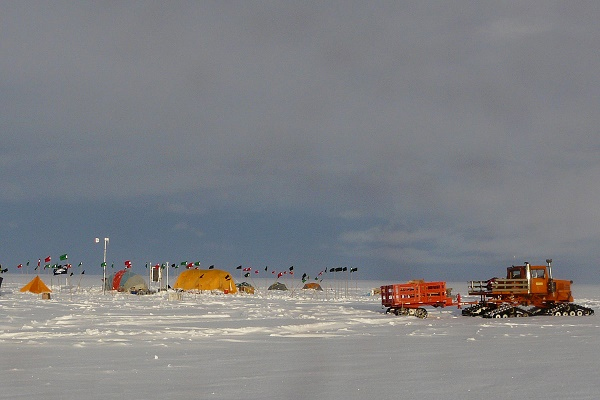
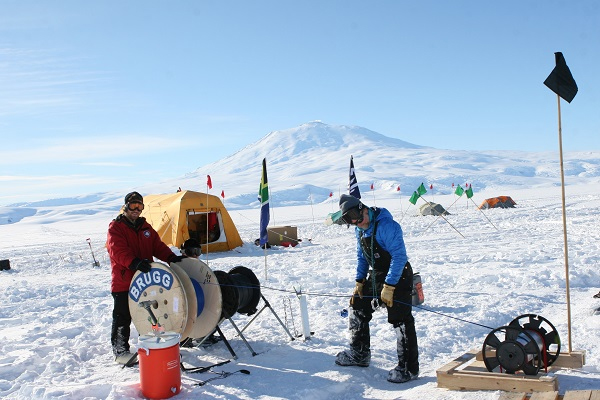
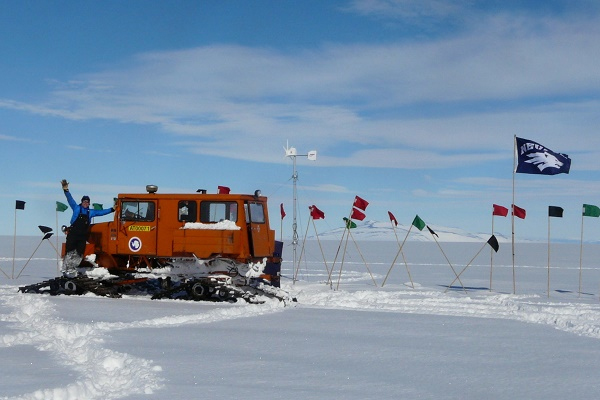
“We were getting data downloads here at home eight times a day, and the system recorded and sent temperatures and pressures perfectly,” Tyler said. “Our goals are to show that we can install these monitoring systems quickly and inexpensively, and then provide continuous data via satellite links throughout the long Antarctic winter.
Back then, Tyler worked with a team of researchers at the desolate spot about 25 kilometers from the McMurdo Station research outpost. Members of the team working with Tyler on the expedition were David Holland, an oceanographer at New York University; Victor Zagorodnov, a glaciologist at Ohio State University; and Alon Stern, a graduate student at New York University.
This year, Tyler joined an international group of 100 scientists to study and quantify the diminishing ice of the West Antarctic ice sheet in five-year program that began in October 2018. He’ll bring his fiber-optic distributed temperature sensing technology to the remote area of Antarctica, the Thwaites Glacier. The scientists are working on eight different research projects funded through the NSF Office of Polar Programs, named “Thwaites: The Future of Thwaites Glacier and its Contribution to Sea-level Rise.”
According to the lead institution f one of the eight research projects, the University of California, Santa Cruz, “Thwaites Glacier has been called the ‘weak underbelly’ of the West Antarctic ice sheet because of its potential to abruptly increase the amount of ice flowing into the ocean, significantly affecting global sea levels. Draining an area roughly the size of Britain or Florida, Thwaites Glacier already accounts for around 4 percent of global sea-level rise, and satellite measurements show that its rate of ice loss has doubled since the 1990s.”
Closer to Home: carbon dioxide and meadow restoration
Ben Sullivan, a Global Water Center member, and his team of scientists are working on a way to stem the tide of carbon dioxide from soils in Sierra Nevada meadows. Their research area stretches much of the length of the Sierra Nevada, from Mt. Lassen to Bishop, California.
One acre of degraded meadow releases as much carbon dioxide as 11 acres of forest takes up
“ One acre of degraded meadow releases as much carbon dioxide as 11 acres of forest takes up,” Sullivan, an assistant professor in the Department of Natural Resources and Environmental Science, said. “We want to quantify aboveground and belowground carbon stocks in meadows and know if an increase in aboveground carbon associated with trees growing in a former meadow is offset by much greater losses of soil carbon below ground.”
“The carbon builds up in the cold, wet meadow soil in the Sierra over thousands of years,” Sullivan said. “But disturbed meadows may be a net source of carbon dioxide and other greenhouse gases, like nitrous oxide and methane, to the atmosphere. We have to understand what is happening in degraded meadows, so we can quantify any positive effects of restoration.
“Because meadows have been restored in the Sierra for the past 15 years, we can measure how carbon stocks change over time and where in the meadow the changes happen and what the levels are. We want to know if meadow restoration could increase the ability of meadow soil to retain and store carbon.”
The team aims to develop a model that can predict how much carbon is sequestered in a meadow. The data may be used by the State of California Air Resources Board to sell carbon credits through their cap and trade program that strives to reduce greenhouse gas emissions in California to 1990 levels by 2020. If the research shows that meadow restoration locks up carbon, the program could allow landowners who restore a meadow area to sell carbon credits – potentially offsetting costs of restoration.
Fallen Leaf Lake’s underwater forest and ancient megadroughts
The conversation about climate change always includes the mention that Earth goes through cycles of warming and cooling, periods of drought and wet periods. Understanding those cycles helps scientists understand the overall picture of how and the influences of what makes climate change. It’s no different at Lake Tahoe, where scientists found 90-foot-tall trees still rooted and standing upright under 120 feet of water at Fallen Leaf Lake, that sits alongside and slightly above Lake Tahoe at the base of the 10,500-foot Mt. Tallac.
Using samples from these trees, University scientists Graham Kent and engineer John Kleppe, dendochronologist Franco Biondi and colleagues Neal Driscoll and Danny Brothers from Scripps Institution of Oceanography in San Diego confirmed ancient 400-year megadroughts with evidence from one of those submerged stands of trees, some as tall as 90 feet, below the surface of Fallen Leaf Lake in the Lake Tahoe Basin.
The trees that lived during the megadrought 1,000 years ago were more than 220 years old before the small, boulder lined and deep mountain lake re-filled with water. In addition to the 11 or so trees, more than 80 trees were found lying on the lake floor at various elevations above the paleoshoreline with evidence that they also had been submerged before falling.
Kent is part of the University of Nevada, Reno and Scripps research team that traced the megadroughts and dry spells of the region using tree-ring analysis, shoreline records and sediment deposition in Fallen Leaf Lake. Using side-scan and multibeam sonar technology developed to map underwater earthquake fault lines such as the West Tahoe fault beneath the surface of Fallen Leaf Lake, the team also imaged the standing trees up to 130 feet beneath the lake surface as well as submerged ancient shoreline structure and development.
Kent had the opportunity to see the trees first-hand using a two-person submersible vehicle.
“It was surreal at first and then more of ‘no biggie,’” Kent said of his first ride in the cramped submarine. “It was kind of more like a theme park ride sensation. We were almost bumping into the trees, about 3-5 feet away.”
“Although the ancient cycle of megadroughts seems to occur every 650 to 1150 years and the last one was 750 years ago, it is uncertain when the next megadrought will occur. With climate change upon us, it will be interesting to see how carbon dioxide loading in the atmosphere will affect this cycle,” Kent said.
Siberian Arctic
Global Water Center director Chandra has been at this climate study business for a few years. In 2010 he was a member of a team of scientists who went to the Siberian Arctic to study the melting permafrost.
“We see the permafrost receding hundreds of yards each year, and the ancient carbon from Pleistocene era plants and animals being unleashed into the air, soil and water,” Chandra said at the time. “Where the carbon goes and how it will affect climate are part of what the team investigated.”
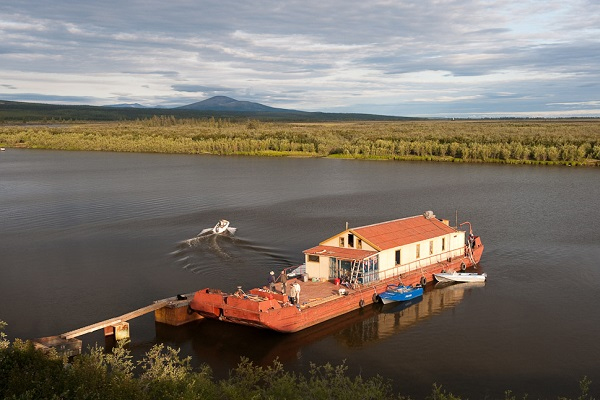
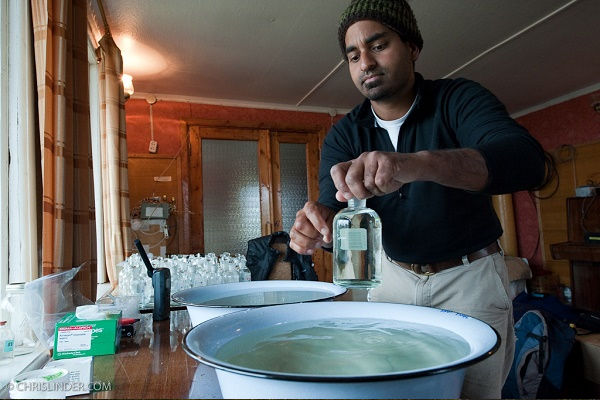
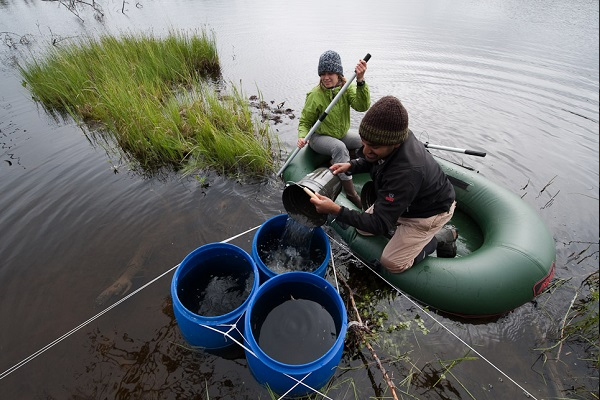
Instead of focusing on a single question in a single ecosystem type, the project participants considered a range of questions across multiple components of the arctic system including forests, tundra, lakes, rivers, estuaries and the coastal Arctic Ocean. The unifying scientific theme was the transport and transformations of carbon and nutrients as they move with water from terrestrial uplands to the Arctic Ocean, which may be causing further global warming.
The Polaris Project in the Siberian Arctic was a collaborative effort by the Woods Hole Research Center, seven universities and colleges, and the Northeast Science Station in Cherskiy, Russia. The project was generously supported by the National Science Foundation's International Polar Year Program.
While Chandra is no longer on the team, the Polaris Project continued there for seven years and has now moved their annual research expedition to target the Yukon – Kuskokwim Delta in Alaska, an area that has relatively “warm” permafrost and vast stores of ancient organic carbon.
Alaska is warming, snowpack dwindling
Climatologist Stephanie McAfee in the Nevada Climate Office and College of Science geography department, is tracking the diminishing snowpack and the warming weather in Alaska.
“Public lands managers wanted projections for snowpack, not just precipitation and temperature, and no one had the snowpack projections,” McAfee said. “So I have updated and analyzed snow projections and vulnerability assessments.”
“They use the data for stream flow projections and timing for salmon runs,” she said. “We have a paper in the very final stages of review on this project.”
Another of her half-dozen or so climate projects in Alaska is one designed to better the understanding of Alaska’s microclimates. McAfee is working with the National Park Service to analyze transects of temperature sensors in Denali National Park to understand how changing temperatures might impact vegetation.
“We go out into the field to place ‘log tags’ (little square sensors with a protective cover) to 15 sites with a couple of logs at each site,” she said. “The transects are from 1,300 to 4,000 feet in elevation, and in the park it’s almost always on an incline, not much level land. It’s a simple system; we use zip ties to attach them to trees. Most are secure, but now and then we find one damaged, like the one we found with teeth marks from a bear.”
Snowmelt changes impact lakes, water systems
Closer to home, warming climate promises to dramatically change how snowmelt provides water to communities and water systems throughout the West.
Western communities are facing effects of a warming climate with slower and earlier snowmelt reducing streamflows and possibly the amount of water reaching reservoirs used for drinking water and agriculture, according to a study published in 2016.
As the climate warms, there is actually a slower snowmelt – both in timing and rates
As the climate warms, there is actually a slower snowmelt – both in timing and rates, which makes for a less efficient streamflow,” Adrian Harpold, ecohydrologist at the University of Nevada, Reno and a member of the Global Water Center, said.
Harpold, who initiated the study at the University of Colorado Boulder, is a co-author of the paper published in AGU publications Geophysical Research Letters.
“I know, it’s counterintuitive, but with a warming climate snowmelt starts sooner in the season, and at a slower rate because the warming occurs earlier when days are shorter and we have less sunlight,” he said. “What makes runoff less efficient is that slower snowmelt reduces the amount of moisture being pushed deep into the subsurface where it is less likely to evaporate”
Higher snow melt rates can develop a pressure gradient that forces moisture deeper into the ground. With lower snow melt rates less water leaves the subsurface where the root systems of trees, bushes and grasses can access the water, which increases the amount of evapotranspiration into the atmosphere.
“It’s ubiquitous in the western U.S.; the trends are consistent to all mountain ranges across the West,” Harpold said.
“The Sierra is affected similarly and, besides the Truckee River basin and Lake Tahoe, Northern California will feel an impact from the reduced and early streamflows,” Harpold said. “The snowpack in the Sierra is one massive reservoir that our communities, forests and river environments have come to rely on.
“Given that 60 million people in the western U.S. depend on snowmelt for their water supply, the future decline in snowmelt-derived streamflow may place additional stress on over-allocated water supplies,” said Noah Molotch the director of the Center for Water Earth Science & Technology CWEST in the CU Boulder Department of Geography, and also a co-author of the paper.
Humid air plays key role in water supplies
The future of snowpack and water resources in the American West now has another variable in the equation for water managers – humidity, which can actually increase snowmelt even on a cloudy day, Harpold said.
In a study published in Proceedings of the National Academy of Sciences, Harpold and his colleague University of Utah Professor Paul Brooks show that changes in humidity may determine how the contribution of snowpack to streams, lakes and groundwater changes as the climate warms.
Surprisingly, cloudy, gray and humid winter days actually cause the snowpack to warm, increasing the likelihood of melt during winter months when the snowpack should be growing, according to the study. In contrast, under clear skies and low humidity the snow can become colder than the air, preserving the snowpack until spring.
Harpold and Brooks, a hydrologist and biogeochemist, looked at snowpack data from more than 400 locations around the West, from the humid Pacific Northwest to the arid Desert Southwest. Across that range of environments, they found that both dry and humid environments responded to climate warming with episodes of snowpack loss during the winter. In humid areas, though, the episodes were primarily winter snowmelt, while in dry areas the episodes were dominated by winter sublimation – direct loss of snow to the atmosphere.
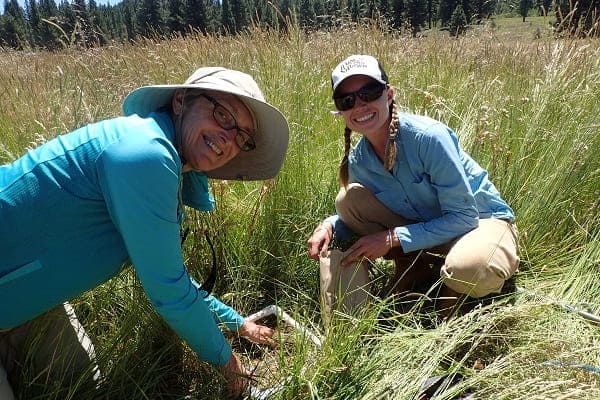

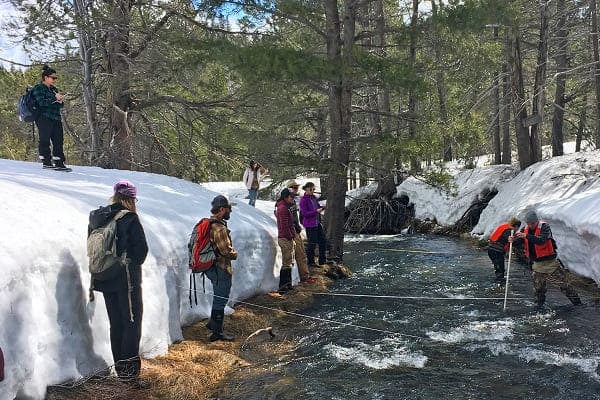
“And these effects are likely to become more intense with more warming,” Harpold said. “We found that relative humidity generally has been both increasing in the Pacific Northwest and decreasing in the desert southwest over the last 30 years, reinforcing the patterns of winter melt in the Pacific Northwest and sublimation in the southwest.”
“Up to now, future trends in winter humidity have not been a focus of prediction,” Harpold said. “Our work shows this will be a key variable that we will have to predict under climate change.”
If humidity increases, water managers may be faced with the challenge of storing water for longer periods while mitigating mid-winter flooding. In contrast, a decrease in humidity will further stress already limited water supplies.
“Long-term planning for reservoirs, water storage and water supply systems is also key for water managers,” Harpold, whose Nevada Mountain Ecohydrology Lab is based in the College of Agriculture, Biotechnology and Natural Resources, said. “For example, in the Sierra and Lake Tahoe you may see a yearly pattern of humid air masses moving over the region, so plans should be made with these regional patterns in mind.
“As we reach a tipping point and see our customary water storage system, the snowpack, melting more and earlier in the winter, systems that rely on snowmelt will need to be reevaluated and modified. It means that trends and patterns in humidity will be very important to the future of snowpack,” Harpold said.
Make an impact on water issues
The Global Water Center is a response to societal demands for creative, integrative approaches in solving complex issues related to water resources. Gifts will support the Center's efforts to translate basic science and research into actionable solutions accessible to stakeholders and will have a direct impact on protecting and improving worldwide water conditions. For more information, please visit the Global Water Center website.
Readers can support the Global Water Center’s mission. Donations will go directly to research and innovation.



